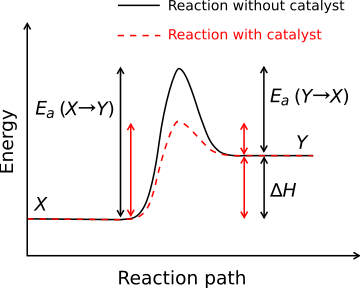Activation energy
2008/9 Schools Wikipedia Selection. Related subjects: Chemistry
In chemistry, activation energy, also called threshold energy, is a term introduced in 1889 by Svante Arrhenius that is defined as the energy that must be overcome in order for a chemical reaction to occur. Activation energy may otherwise be denoted as the minimum energy necessary for a specific chemical reaction to occur. The activation energy of a reaction is usually denoted by Ea, and given in units of kilojoules per mole.
Usually one can think of the activation energy as the height of the potential barrier (sometimes called the energy barrier) separating two minima of potential energy (of the reactants and of the products of reaction). For a chemical reaction to have noticeable rate, there should be noticeable number of molecules with the energy equal or greater than the activation energy.
Transition states
For many reactions the activation energy roughly corresponds to the height of the transition state barrier. The transition state along a reaction coordinate is the point of maximum free energy, where bond-making and bond-breaking are balanced. Multi-step reactions involve a number of transition states. The rate-limiting step (corresponding to the overall activation energy) is that with the highest transition state barrier.
However, for a large number of reactions (those with loose transition states, those in which tunneling is significant, barrierless reactions) the height of the highest barrier on the reaction path does not correspond to the activation energy implied by the temperature dependence of the reaction rate (see Arrhenius equation). In these cases one may think about the activation energy as the height of an effective barrier that would give the same rate were these effects not present.
It should be noted that [IUPAC] has removed any reference to transition states in their definition of activation energy (see external links).
Negative activation energy
In some cases rates of reaction decrease with increasing temperature. When following an approximately exponential relationship so the rate constant can still be fit to an Arrhenius expression, this results in a negative value of Ea. Reactions exhibiting these negative activation energies are typically barrierless reactions, in which the reaction proceeding relies on the capture of the molecules in a potential well. Increasing the temperature leads to a reduced probability of the colliding molecules capturing one another (with more glancing collisions not leading to reaction as the higher momentum carries the colliding particles out of the potential well), expressed as a reaction cross section that decreases with increasing temperature. Such a situation no longer leads itself to direct interpretations as the height of a potential barrier.
Temperature independence and the relation to the Arrhenius equation
The Arrhenius equation gives the quantitative basis of the relationship between the activation energy and the rate at which a reaction proceeds. From the Arrhenius equation, the activation energy can be expressed as
where A is the frequency factor for the reaction, R is the universal gas constant, and T is the temperature (in kelvin). While this equation suggests that the activation energy is dependent on temperature, in regimes in which the Arrhenius equation is valid this is cancelled by the temperature dependence of k. Thus Ea can be evaluated from the rate constant at any temperature (within the validity of the Arrhenius equation).
Catalysis

A substance that modifies the transition state to lower the activation energy is termed a catalyst; a biological catalyst is termed an enzyme. It is important to note that a catalyst increases the rate of reaction without being consumed by it. In addition, while the catalyst lowers the activation energy, it does not change the energies of the original reactants nor products. Rather, the reactant energy and the product energy remain the same and only the activation energy is altered (lowered).

